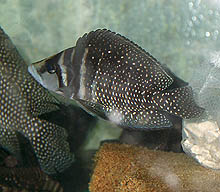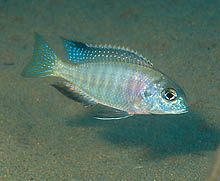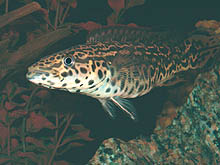WHAT'S NEW ACROSS THE WORLD
What's
new April 2000
What's
new July 2000
What's
new October 2000
What's
new January 2001
What's
new April 2001
What's
new July 2001
What's
new October 2001
What's
new January 2002
What's
new April 2002
What's
new July 2002
What's
new October 2002
What's
new January 2003
| What's New ©by
Laif DeMason
Despite winter’s persistent cold and snow coupled
with the sluggish economy, people are buying cichlids in good numbers.
Sales of most items on the cichlid shelf are strong. Interest in Tanganyikan
species this year has increased to levels beyond any of the previous five
years. With more interest, collectors have pushed for new items, even if
some are “new” in name only. Spotty shortages are reported from breeders
in a few bred items of African cichlids. Prices are still the lowest —
compared to the last 30 years or so — thus making fish-buying a bargain
given the wide selection of cichlids available nowadays. Hobbyists are
encouraged to take a trip to their nearest supplier and take a look!
Here’s “what’s new” on the cichlid scene: |
Lake Tanganyika
Exports are very active from Zambia, Tanzania, and Burundi. Collections
from the Congo coastline are occurring with more regular activity promised.
Bred supplies of Tanganyikan cichlids are selling well with shell-dwellers
now gaining popularity. A flood of “blue” forms of Cyphotilapia frontosa
collected from various locations has entered the scene. I wonder — if they
were all put in the same aquarium for a day, could anyone — even an “expert”
— tell them apart?
|
what's new: Lake Tanganyika
|

Several varieties of Cyprichromis leptosoma are
being exported; one type from Kigoma (Tanzania) sports a yellow body and
powder blue fins. |

Collected near Ikola (Tanzania), this jumbo version
of Eretmodus cyanostictus is marked with strong reddish hues. |

Exported from Zambia, a “new” Altolamprologus calvus
sold as “inkspot” has a purple sheen on the head. |

With increasing interest, shell-dwellers such as ‘Lamprologus’
ocellatus “gold” have been popular choices of late. |
Lake Malawi
All the collectors and exporters on Lake Malawi are hitting areas that
are infrequently visited. Thus a new wave of items is appearing, some for
the first time! Areas in Mozambique are being collected more often of late,
as well as out of the way places in Tanzania. The search goes on for the
latest cichlids!

From Cobue (Mozambique) comes a new Metriaclima
hajomaylandi (aka “Ps. greberi”) sporting golden markings that
extend far back over the body. |

From Lion’s Cove (Malawi), Pseudotropheus polit
is a small mbuna that often shows black markings on the head, but can
change completely to light blue! Photo by A. Konings. |

A version of Copadichromis trewavasae from
Londo (Mozambique) sports a black body, unlike the original “mloto” from
Likoma. |

A new Protomelas ‘steveni’ has appeared from
Nkhata Bay (Malawi) sporting red markings instead of the usual yellow.
(No, this is not a Red Empress!). |

From the extreme north of Lake Malawi, Lethrinops
sp. “Mdoka red” is infrequently encountered for collection. Photo by A.
Konings. |

Also sporadically collected for export from Tanzania,
Buccochromis spectabilis is a rare find! Photo by M. Hyuga. |
Lake Victoria
Not much to report for Victoria basin cichlid fans. No new collections
of wild material have been reported. Hopefully with time this situation
will change. For now, bred material is the only source. Be careful of the
“pedigree” of the strain you are considering!
West Africa and Madagascar
Collections and exports of riverine forms from Congo, Cameroon, Guinea,
and Nigeria are in seasonal swing. Several species of Pelvicachromis, ‘Chromidotilapia’,
Nanochromis, and Teleogramma not often seen are currently available. Interest
in cichlids from Madagascar is also on the rise. Bred material is still
the best and most reliable source. A new book on these interesting Malagasy
fishes by Patrick de Rham and Jean-Claude Nourrisat is currently available
in French.
Neotropics
Seasonal collections are high at the moment from countries in South
America. Importers have complained that due to airline flight cut-backs,
shipments from Brazil are hard to schedule as weekly capacities on board
have been reduced. Currently several breeders, some in Florida, are producing
many of the less common New World cichlids. Supplies of European bred Apistogramma
and other dwarf species are still good.

Originally from Argentina where sporadic exports have
occurred over the years, Gymnogeophagus australis is currently bred
by hobbyists. Photo by J. Rapps. |

From Peru, Tahuantinsuyoa macanzatza is an
infrequently-seen delayed mouthbrooder. Photo by J. Rapps. |

Extremely rare in the trade, Nandopsis ramsdeni
is from the island nation of Cuba. Photo by J. Rapps. |

Known as Cobra Pike, Crenicichla sp. Tapajos
II is a colorful, large cichlid from Rio Tapajos, Brazil. Phot by K. Devlin. |
|













